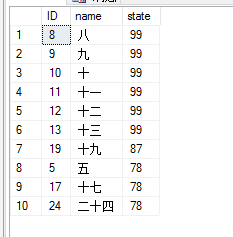1、select 指定的字段要么要包括在聚合函数中,要么就要跟在group by的后面作为分组的依据。
PS:可以用Max()函数括起来必须要查的非数字型的字段。
2、distinct 用于返回唯一不同的值
例:select distinct company from orders。--一个公司名称只能查询到一次
3、12356 和12346
union all 12356 12346 (显示所有的数据)
union 结果集 123456 (并集,包含所有的元素,去除重复的值)
intersect 1236 (交集)
4、一次插入多条数据
a:
insert into tableA (列一,列二)
select 值一,值二
union /union all -----union 是相同值记录只插入一次,不重复插入 union all会重复插入
select 值三,值四
b:
insert into tableA(列一,列二) values(值一,值二),(值3,值4),(值5,值6),(值7,值8),(值9,值10)
c:从另一个表中读取多条数据添加到新表中
insert into table(lie1,lie2)
select a,b from tableA where a=1-----从一个表中读取数据
insert into table(lie1,lie2)
select a,b from tableA where a=1
union all
select a,b from tableB where a=2 ---从多个表中读取数据
5、Case when then else end
---简单的
Case Sex
when '1' then ‘男’
when '2' then ‘女’
else ‘其他’
END
---搜索函数
Case when sex=1 then ‘男’
sex= '2' then ‘女’
else ‘其他’
END
6、decimal(a,b) 规定的是存储的值不会超过a位数字,小数点后面有b位 0=<b=<a
例:decimal(5,2)存储的值不会超过5位数字,小数点后面有2位数字
7、decimal float double的区别
float:浮点型,含字节数为4,32bit,数值范围为-3.4E38~3.4E38(7个有效位)
double:双精度实型,含字节数为8,64bit数值范围-1.7E308~1.7E308(15个有效位)
decimal:数字型,128bit,不存在精度损失,常用于银行帐目计算。(28个有效位)
float f = 345.98756f;--结果显示为345.9876,只显示7个有效位,对最后一位数四舍五入。 double d=345.975423578631442d;--结果显示为345.975423578631,只显示15个有效位,对最后一位四舍五入。 --注:float和double的相乘操作,数字溢出不会报错,会有精度的损失。float与double相乘结果类型是double decimal dd=345.545454879.....--可以支持28位,对最后一位四舍五入。 --:当对decimal类型进行操作时,数值会因溢出而报错。
8、with ties
select top 8 * from tablett order by state desc

select top 8 with ties * from tablett order by state desc

区别就是用了with ties 最后一行的参数值(在这句里是state相同 ) 如果相同的话 会都显示出来
额外的返回行的参数值与TOP n(PERCENT)行中的最后一行的该参数值相同。这个地方该怎么理解呢?其实是如果按照order by 参数排序TOP n(PERCENT)返回了前面n(pencent)个记录,但是n+1…n+k条记录和排序后的第n条记录的参数值(order by 后面的参数)相同,则n+1、…、n+k也返回。n+1、…、n+k就是额外的返回值。